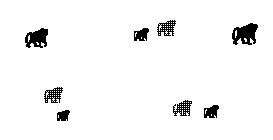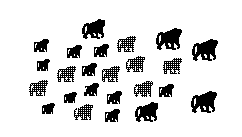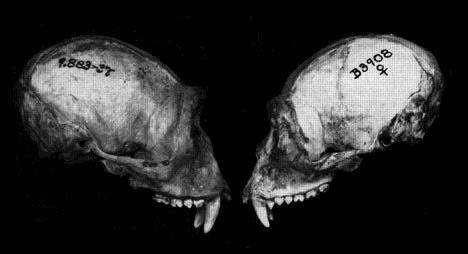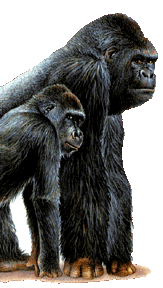"Social organization"
"Social organization" tends to be all-encompassing
and a rather vague concept. Social organizations among primates vary primarily
on the basis of the following factors:
1. Group Size
2. Group Composition
3. Mating Systems
4. Social Roles - especially
for adult females and males
5. Various Types of Dominance
6. Permanence versus Instability
of Group Membership
7. Tendency to Aggregate into
Larger Social Groups
8. Presence of only Heterosexual
Reproductive Units, All-Male
Groups or All-Female Groups,
or Single Individuals
9. Patterns of Interactions.
The best way to examine primate
societies may be to divide them into groups based on: (A) large troops,
medium-size groups, and small units, or (B) multi-female and multi-male;
uni-male and multi-female; uni-male and uni-female, or (C) multiple mating
by males and females, polygynous, and monogamous.
Several trends can be noted if we
look at these possible ways to group primate societies. First, monogamous
groups are small, normally containing only one fully adult female and one
fully adult male and their offspring. Gibbons fit this model well. Second,
a system of multiple matings by both females and males or multi-females
are usually the largest of primate societies. Some groups can reach 300
individuals in these cases. Third, polygynous groups contain one adult
male and several adult females and off-spring and are moderate in size.
Gorilla troops fit this profile. Keep in mind that polygynous groups such
as this, also called harems, maximize reproduction by keeping a pool of
receptive females available. It is also true that the greatest sexual dimorphism
- difference in size between males and females - occur in polygynous societies.
Primates that live in monogamous
societies exhibit the following features: a lack of sexual dimorphism in
size and coloration; a lack of specialized defense roles against predators
by adult males; highly developed territoriality in both sexes; extensive
care of young by the adult male; and closely fashioned activities by adult
female and male.
Primates that live in polygymous
groups typically show the following characteristics: closely bonded  adult
females, somewhat peripheral or socially aloof reproductive male; strong
intolerance by the reproductive males of other, potentially reproductive
males; leadership shown by at least some females in many aspects of group
life, while the adult male shows an outward-from-the-group orientation;
some turnover in reproductive males.
adult
females, somewhat peripheral or socially aloof reproductive male; strong
intolerance by the reproductive males of other, potentially reproductive
males; leadership shown by at least some females in many aspects of group
life, while the adult male shows an outward-from-the-group orientation;
some turnover in reproductive males.
All primates are
social animals. They interact on a regular basis with each other. Most
tend to move, feed, and sleep in groups. The composition of these groups
differs from species to species. The following terms are used by primatologists
to characterize primate social groups: noyau, monogamous, polyandrous,
multimale, one-male, and fission-fusion societies.
The simplest social group found
among primates is the noyau. It is commonly found among noctural  primates
and is based on an individual female and her offspring. Adult males and
females do not form permanent mixed-sex groups nor do males and females
tend to travel with each other. Individual males have ranges that overlap
several different female ranges.
primates
and is based on an individual female and her offspring. Adult males and
females do not form permanent mixed-sex groups nor do males and females
tend to travel with each other. Individual males have ranges that overlap
several different female ranges.
The monogamous "family" consists
of one adult female, one male, and their offspring. Nonhuman primates that
are monogamous tend to mate for life and are usually highly territorial.
Gibbons and Indris are both typical of monogamous primates. In each case,
these species are highly vocal and use loud calls to warn others that they
"own" a territory.
The polyandrous groups consist of
a single reproducing female and several sexually active males. In these
groups, several of the males usually participate in the care of offspring.
Many primate species live in groups
consisting of a single adult male along with several females and their offspring. Adult males not living with females
form separate bands (all-male) or live alone as bachelors. The one-male
groups are almost invariably characterized by repeated efforts by outside
males to takeover the position of the resident male. In many instances,
dependent infants are killed as a result of a change in the status of a
resident male. Competition is high in the one-male society.
several females and their offspring. Adult males not living with females
form separate bands (all-male) or live alone as bachelors. The one-male
groups are almost invariably characterized by repeated efforts by outside
males to takeover the position of the resident male. In many instances,
dependent infants are killed as a result of a change in the status of a
resident male. Competition is high in the one-male society.
 Another
type of social grouping among primates is the multimale group. Such groups
are characterized by complex intratroop politics and competition. These
groups tend to become relatively large in size with several males and numerous
females and offspring.
Another
type of social grouping among primates is the multimale group. Such groups
are characterized by complex intratroop politics and competition. These
groups tend to become relatively large in size with several males and numerous
females and offspring.
Among the Gombe Stream chimpanzees
that Jane Goodall has studied is still another form of primate society known as fission-fusion. The social group tends to separate (fission)
and then periodically join (fusion) for feeding in rich areas for example.
Individuals, females and their offspring, or temporary groups (harems,
all-male groups, for example) tend to form associations on a temporary
basis for various reasons. Yet, the group as a whole tends to reunite in
the ebb and flow of changing activities.
society known as fission-fusion. The social group tends to separate (fission)
and then periodically join (fusion) for feeding in rich areas for example.
Individuals, females and their offspring, or temporary groups (harems,
all-male groups, for example) tend to form associations on a temporary
basis for various reasons. Yet, the group as a whole tends to reunite in
the ebb and flow of changing activities.
Primate social groupings are
the result of many selective factors that influence the size, composition,
and dynamics of the group. It is the dynamics between individuals that
is of most importance to primate behavioral studies. One other aspect of
primate social behavior is important. Many studies demonstrate that the
social behavior for one species frequently changes with differences in
resource availability or even demographic fluxuations. This only reinforces
the idea that primate social groups are the product of selection. Therefore,
primate social groups have tended to evolve as a means for survival around
a variety of reproductive strategies. Advantages and disadvantages are
balanced through behavior responses that one finds in different primate
social groups.
Sexual Dimorphism
and Size of Canines can be correlated to behaviors
relating to social organization. Sexual dimorphism is greatest and canines
large in polygynous societies. This tends also to be true in multi-male
and multi-female groups. Even in size is the rule for monogamous societies.
The following picture of a male and female gibbon skull show a remarkable
size similarity reflecting the lack of competition in a male-female bonding
behaviors among gibbons. The fossil record indicates that human sexual
dimorphism (the size differences between males and females) has decreased
over time but once was at a scale similar to gorillas where males are nearly
70% bigger than females.

 Given
that gorillas tend to maximize care of infants and juveniles and estrus
biologically shuts down for a prolonged period in females, can you understand
why gorillas live in harems (polygymous socities)?
Given
that gorillas tend to maximize care of infants and juveniles and estrus
biologically shuts down for a prolonged period in females, can you understand
why gorillas live in harems (polygymous socities)?
Keep in mind that primate social
organization is varied. It is becoming clear that there are differences
between troops of chimpanzees or baboons. There are differences, for example,
that are striking between the chimpanzees that Jane Goodall has studied
in the Gombi area (as seen in the video People of the Forest) and a group
of chimpanzees known as Bonobo Chimpanzees (see reading on Bonobo Society
by Franz DeWaal.)
 adult
females, somewhat peripheral or socially aloof reproductive male; strong
intolerance by the reproductive males of other, potentially reproductive
males; leadership shown by at least some females in many aspects of group
life, while the adult male shows an outward-from-the-group orientation;
some turnover in reproductive males.
adult
females, somewhat peripheral or socially aloof reproductive male; strong
intolerance by the reproductive males of other, potentially reproductive
males; leadership shown by at least some females in many aspects of group
life, while the adult male shows an outward-from-the-group orientation;
some turnover in reproductive males.
 primates
and is based on an individual female and her offspring. Adult males and
females do not form permanent mixed-sex groups nor do males and females
tend to travel with each other. Individual males have ranges that overlap
several different female ranges.
primates
and is based on an individual female and her offspring. Adult males and
females do not form permanent mixed-sex groups nor do males and females
tend to travel with each other. Individual males have ranges that overlap
several different female ranges.
 several females and their offspring. Adult males not living with females
form separate bands (all-male) or live alone as bachelors. The one-male
groups are almost invariably characterized by repeated efforts by outside
males to takeover the position of the resident male. In many instances,
dependent infants are killed as a result of a change in the status of a
resident male. Competition is high in the one-male society.
several females and their offspring. Adult males not living with females
form separate bands (all-male) or live alone as bachelors. The one-male
groups are almost invariably characterized by repeated efforts by outside
males to takeover the position of the resident male. In many instances,
dependent infants are killed as a result of a change in the status of a
resident male. Competition is high in the one-male society.
 Another
type of social grouping among primates is the multimale group. Such groups
are characterized by complex intratroop politics and competition. These
groups tend to become relatively large in size with several males and numerous
females and offspring.
Another
type of social grouping among primates is the multimale group. Such groups
are characterized by complex intratroop politics and competition. These
groups tend to become relatively large in size with several males and numerous
females and offspring.
 society known as fission-fusion. The social group tends to separate (fission)
and then periodically join (fusion) for feeding in rich areas for example.
Individuals, females and their offspring, or temporary groups (harems,
all-male groups, for example) tend to form associations on a temporary
basis for various reasons. Yet, the group as a whole tends to reunite in
the ebb and flow of changing activities.
society known as fission-fusion. The social group tends to separate (fission)
and then periodically join (fusion) for feeding in rich areas for example.
Individuals, females and their offspring, or temporary groups (harems,
all-male groups, for example) tend to form associations on a temporary
basis for various reasons. Yet, the group as a whole tends to reunite in
the ebb and flow of changing activities.

 Given
that gorillas tend to maximize care of infants and juveniles and estrus
biologically shuts down for a prolonged period in females, can you understand
why gorillas live in harems (polygymous socities)?
Given
that gorillas tend to maximize care of infants and juveniles and estrus
biologically shuts down for a prolonged period in females, can you understand
why gorillas live in harems (polygymous socities)?